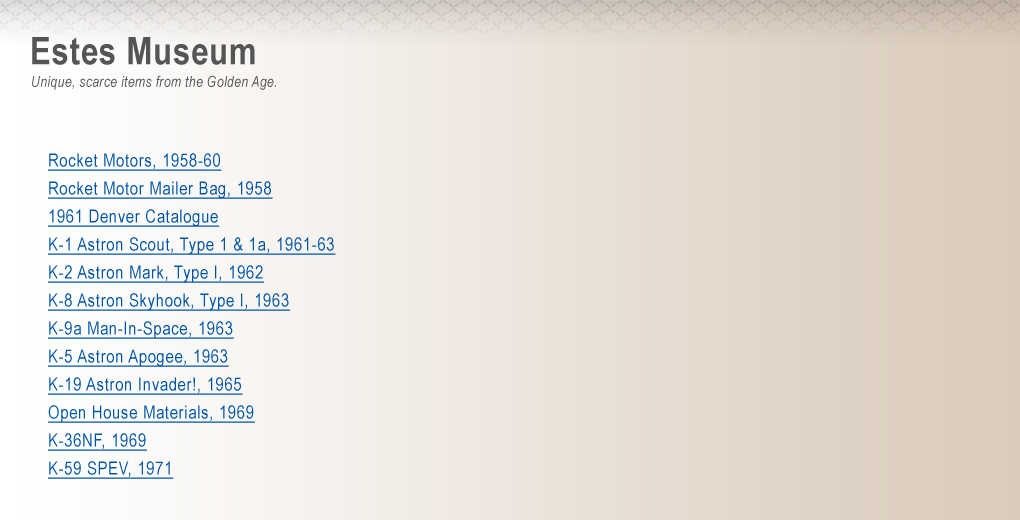 |
|
|
Rocket Motors from 1958-60
|
|
 |
|
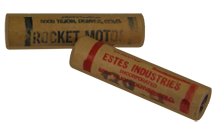 Finding Rocket Motors
from 1958-60 is very difficult, and locating pristine
motors from this time is next to impossible. These two
beautiful Rocket Motors were constructed on Vern's
rocket motor-making machine Mabel. More than
likely, these motors were made by Vern, Gleda or Jim
Berns. You just don't see these anymore, and they
definitely belong in a museum. Many collectors have
never even seen an original Denver Motor - even after
many years of collecting.
Finding Rocket Motors
from 1958-60 is very difficult, and locating pristine
motors from this time is next to impossible. These two
beautiful Rocket Motors were constructed on Vern's
rocket motor-making machine Mabel. More than
likely, these motors were made by Vern, Gleda or Jim
Berns. You just don't see these anymore, and they
definitely belong in a museum. Many collectors have
never even seen an original Denver Motor - even after
many years of collecting.
Rocket Motors courtesy of the
Andy Andres collection
|
 |
| |
|
Rocket Motor Mailer, 1959
|
|
 |
|
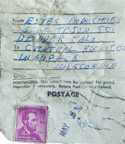 Back in the very early days of Estes Industries, rocket
motors were shipped in canvas Rocket Motor
Mailing bags.
I learned from Vern that these bags were used for an
extremely short period - months at best - and finding
one that survives is next to impossible. The bags were
eventually supplanted with the red tube mailers, and are
extremely difficult to locate. The example here from
Vern's private museum dated May 8, 1959 may be the lone
surviving piece.
Back in the very early days of Estes Industries, rocket
motors were shipped in canvas Rocket Motor
Mailing bags.
I learned from Vern that these bags were used for an
extremely short period - months at best - and finding
one that survives is next to impossible. The bags were
eventually supplanted with the red tube mailers, and are
extremely difficult to locate. The example here from
Vern's private museum dated May 8, 1959 may be the lone
surviving piece.
Rocket Motor mailer courtesy of
the Vernon Estes museum
|
 |
|
|
1961 Denver Catalogue
|
|
 |
|
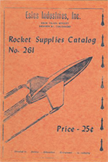 The 1961
Denver Catalogue is the
rarest of all the Estes catalogues, and its very
unlikely any new copies will be discovered. At present,
its estimated that less than 10 survive (only 200 were
made). The catalogue
featured just one kit - The
K-1 Astron Scout, stitched
together on Gleda's sewing machine, and was only 20
pages. The
1961 Denver Catalogue is
considered the "Holy Grail" of Estes catalogue
collecting. The 1961
Denver Catalogue is the
rarest of all the Estes catalogues, and its very
unlikely any new copies will be discovered. At present,
its estimated that less than 10 survive (only 200 were
made). The catalogue
featured just one kit - The
K-1 Astron Scout, stitched
together on Gleda's sewing machine, and was only 20
pages. The
1961 Denver Catalogue is
considered the "Holy Grail" of Estes catalogue
collecting.
|
|
|
 |
|
|
K-1 Astron Scout, Type I & Ia,
1961-63
|
|
 |
|
 Early K-1 Astron Scout
kits were packaged and mailed in the same red tubes
Estes was using at the time to mail rocket-engines. The
kit fit perfectly into the tubes, and the sturdy
construction kept the contents in new condition. Its a
safe bet to assume that nearly all of these were opened,
built and flown, and finding one that survives today is
a very difficult at best. Even the tubes they were
shipped in could be used as body tubes in home-made
designs, all the more reason finding a complete Type
I or Type Ia Astron Scout is very,
very difficult.
Early K-1 Astron Scout
kits were packaged and mailed in the same red tubes
Estes was using at the time to mail rocket-engines. The
kit fit perfectly into the tubes, and the sturdy
construction kept the contents in new condition. Its a
safe bet to assume that nearly all of these were opened,
built and flown, and finding one that survives today is
a very difficult at best. Even the tubes they were
shipped in could be used as body tubes in home-made
designs, all the more reason finding a complete Type
I or Type Ia Astron Scout is very,
very difficult.
K-1 Astron Scout, Type Ia from the
Higgins collection
|
 |
|
|
|
K-2 Astron Mark, Type I, 1962
|
|
 |
|
 The K-2 Astron
Mark instruction and face card
sheet underwent a subtle change early after it's initial
release. The Type I has the words "Manufactured by" in
a round Arial font, and was only in use for a very short time.
Soon after its release, the font was changed to a Serif type font, and is much more common. This
Type I
Astron Mark
is stapled closed and is
very difficult to obtain in any condition.
The K-2 Astron
Mark instruction and face card
sheet underwent a subtle change early after it's initial
release. The Type I has the words "Manufactured by" in
a round Arial font, and was only in use for a very short time.
Soon after its release, the font was changed to a Serif type font, and is much more common. This
Type I
Astron Mark
is stapled closed and is
very difficult to obtain in any condition.
K-2 Astron Mark from the
Higgins collection
|
 |
|
|
K-8 Astron Skyhook, Type I,
1963
|
 |
|
 Early K-8 Astron Skyhook
kits were packed with PM-1
and stapled closed. The kit was one of the best sellers
at the time, so locating one in any condition is
extremely difficult. The Type I
Astron Skyhook had the crude, hand-drawn
rocket-graphic on the Facecard making it highly
sought after by collectors.
Early K-8 Astron Skyhook
kits were packed with PM-1
and stapled closed. The kit was one of the best sellers
at the time, so locating one in any condition is
extremely difficult. The Type I
Astron Skyhook had the crude, hand-drawn
rocket-graphic on the Facecard making it highly
sought after by collectors.
K-8 Astron Skyhook from
the Higgins collection
|
 |
|
|
|
K-9A Man-In-Space, 1963
|
|
 |
|
 The K-9A Estes
Man-In-Space from 1963 may be the rarest
of all Estes kits. Here's why: In 1963, the
Estes Man-In-Space was offered as a free kit (with
a $5 purchase) in
the April/May 1963 Model Rocket News. In the
August/September 1963 issue of the Model Rocket News, the
kit was renamed the Astron Spaceman, and would
make its debut in the
1964 catalogue. That means that
for just four months, you could obtain a Man-In-Space as
a free kit with a minimum $5 order (what kid had $5 in
1963?). Add to the
fact that the kit contains the easily crushable BT-60N,
and you have a rare, fragile kit that is impossible to find.
The K-9A Estes
Man-In-Space from 1963 may be the rarest
of all Estes kits. Here's why: In 1963, the
Estes Man-In-Space was offered as a free kit (with
a $5 purchase) in
the April/May 1963 Model Rocket News. In the
August/September 1963 issue of the Model Rocket News, the
kit was renamed the Astron Spaceman, and would
make its debut in the
1964 catalogue. That means that
for just four months, you could obtain a Man-In-Space as
a free kit with a minimum $5 order (what kid had $5 in
1963?). Add to the
fact that the kit contains the easily crushable BT-60N,
and you have a rare, fragile kit that is impossible to find.
K-9A Estes Man-In-Space from the
Higgins collection
|
 |
|
|
K-5 Astron Apogee, 1963
|
|
 |
|
 Finding an original, short-body
K-5 Astron Apogee
from 1963 will take years, assuming there are any left
to be discovered. This rare kit was only
in production for less than a year until being
supplanted by the
K-5 Astron Apogee II in 1964.
Packed with PM-1 and
stapled closed, this is one of the rarest, and difficult
to obtain of the K-Kits. Many collectors who are
building a complete collection of K-Kits will tell you
this is one of the most difficult kits to obtain in any
condition. Finding an original, short-body
K-5 Astron Apogee
from 1963 will take years, assuming there are any left
to be discovered. This rare kit was only
in production for less than a year until being
supplanted by the
K-5 Astron Apogee II in 1964.
Packed with PM-1 and
stapled closed, this is one of the rarest, and difficult
to obtain of the K-Kits. Many collectors who are
building a complete collection of K-Kits will tell you
this is one of the most difficult kits to obtain in any
condition.
|
 |
|
|
K-19 Astron
Invader!, 1965
|
|
 |
|
 Finding
a
K-19 Astron
Invader
from 1965 will likely take very careful searching. This rare
kit was only in production for 18 months, making it one
of the shortest kit production runs in the company's
history. Perhaps the high skill-level required to
build her was to blame for the lack of interest in this
beautiful glider, and as such you just don't find these
anymore. This pristine example here is one of a few
known surviving kits. Locating a
K-19 Astron Invader in
any condition is next to impossible. Finding
a
K-19 Astron
Invader
from 1965 will likely take very careful searching. This rare
kit was only in production for 18 months, making it one
of the shortest kit production runs in the company's
history. Perhaps the high skill-level required to
build her was to blame for the lack of interest in this
beautiful glider, and as such you just don't find these
anymore. This pristine example here is one of a few
known surviving kits. Locating a
K-19 Astron Invader in
any condition is next to impossible.
K-19 Astron Invader! from the the
Higgins collection
|
 |
|
|
Open House
Materials, 1969
|
|
 |
|
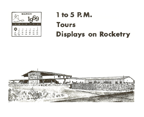 The Estes Open House event that took
place on March 2, 1969 was the crescendo at Estes before
the acquisition by Damon Corp. These invitations were
sent to heads of local businesses, the governor (who
could not attend) and many other important people of the
time. The handout was given to the guests who attended. This
example may be the lone surviving pair,
located in a box of materials from the late Jean
Fowler's estate. Jean worked at Estes, and after
retirement this item remained with her until its sale in
2007.
The Estes Open House event that took
place on March 2, 1969 was the crescendo at Estes before
the acquisition by Damon Corp. These invitations were
sent to heads of local businesses, the governor (who
could not attend) and many other important people of the
time. The handout was given to the guests who attended. This
example may be the lone surviving pair,
located in a box of materials from the late Jean
Fowler's estate. Jean worked at Estes, and after
retirement this item remained with her until its sale in
2007.
Estes Open-House materials
courtesy of the Joe Warner collection
|
 |
|
|
K-36NF Saturn V, 1969
|
|
 |
|
 The K-36NF is a non-flying
version of the 1/100th scale Saturn-V that had a very
limited production run in 1969. 300 kits were delivered to
the Kennedy Space Center in time for the launch of Apollo
10, and an additional 300 kits were shipped the following
week. Of the 600 kits that were produced, this example is
one of but 3 known. During the race for space in the mid to
late 1960's, the Kennedy Space Center hosted alot of
visitors, and as such, these kits sold quickly. Many of
the kits ended up built or taken back abroad, so
finding a
K-36NF
is next to impossible.
The K-36NF is a non-flying
version of the 1/100th scale Saturn-V that had a very
limited production run in 1969. 300 kits were delivered to
the Kennedy Space Center in time for the launch of Apollo
10, and an additional 300 kits were shipped the following
week. Of the 600 kits that were produced, this example is
one of but 3 known. During the race for space in the mid to
late 1960's, the Kennedy Space Center hosted alot of
visitors, and as such, these kits sold quickly. Many of
the kits ended up built or taken back abroad, so
finding a
K-36NF
is next to impossible.
K-36NF
courtesy of the Earl Cagle collection
|
 |
|
|
|
K-59 SPEV, 1971
|
 |
|
 The K-59 SPEV
has the distinction of being the last
true K-Kit from the golden age. According to Bill Simon,
the SPEV was a Surplus
Parts
Elimination Vehicle
created to eliminate spare parts
in the warehouse. According to Simon: The K-59 SPEV
has the distinction of being the last
true K-Kit from the golden age. According to Bill Simon,
the SPEV was a Surplus
Parts
Elimination Vehicle
created to eliminate spare parts
in the warehouse. According to Simon:
"The story behind that is that
John Hood, our warehouse manager, used the visual system
of inventory control: if the bin in his warehouse looked
to be near empty, he’d tell George Miller, our
purchasing agent, to order more. At some point orders
from Euclid, our body tube supplier, were slow coming
in, so John, on his next weekly round, would dutifully
note that the BT-xx bin was empty and tell George to
order more. George in turn would place the purchase
order. A few weeks like that and we ended up with a
50-year supply of a couple of items. The “Surplus Parts
Elimination Vehicle (SPEV)” was purely a way to correct
the imbalance, and it was discontinued as soon as it had
done its job."
The
SPEV is one of the most difficult kits
to obtain. Given the kits history, the SPEV holds a
special place among collectors. It signifies the end of
the golden age and gives us an insight into how Estes
dealt with their surplus parts. Not too many
SPEV's were produced, and as such, it's very
difficult to locate in any condition.
K-59 Facecard from the the
Higgins collection

|
|
|
![]() Back to the Previous Page
Back to the Previous Page
![]() Estes Museum
Estes Museum